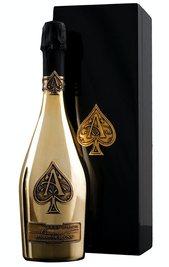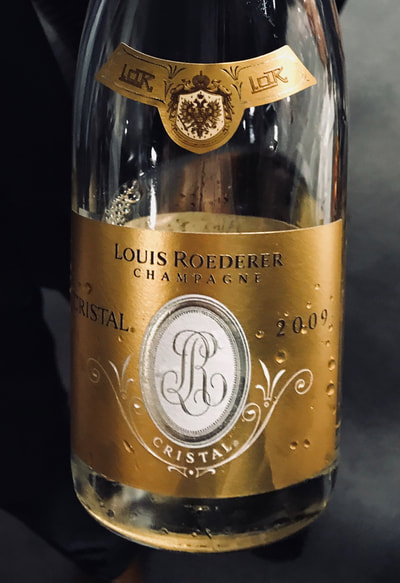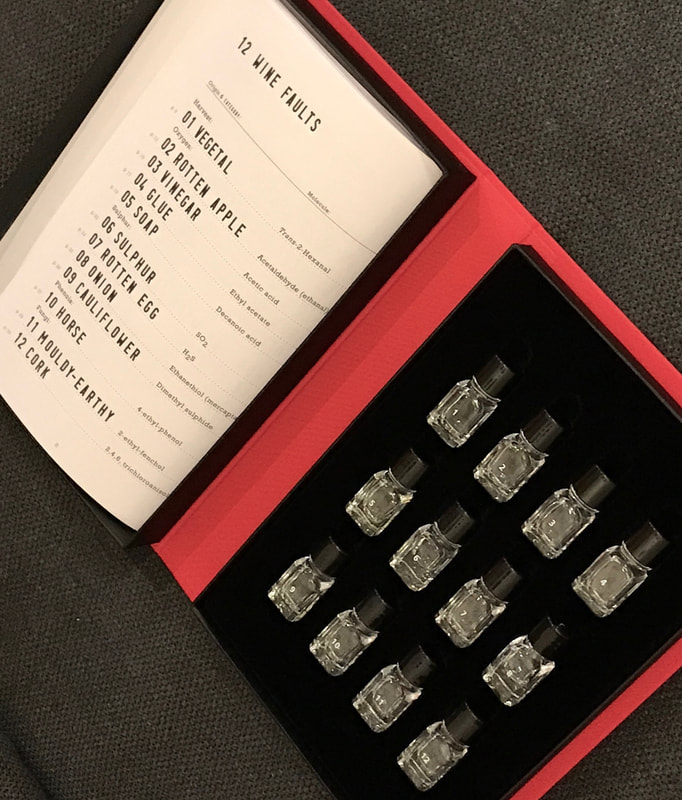|
While I was at my Champagne tasting event last night in Bordeaux, I came across the Louis Roederer Champagne producer. I tried the Vintage 2009, and enjoyed the citrusy lemon and grapefruit flavors with a note of brioche. At the counter, I noticed one of the staff would take out a bottle not on the tasting list, and give it a pour to a few of the tasters around him. I ended up with this mysterious vintage in my glass, but as he turned the bottle I saw Cristal 2009 – one of the most prestigious cuvées from the Champagne house. The name ‘Cristal’ actually refers to the crystal bottles that were used to bottle the Champagne for Tsar Alexandar II in 1876. I wasn’t exactly thrilled because the moment I saw the label I recalled a chapter from Mike Veseth’s book on Extreme Wine (2013). If you’ve never heard of Mike Veseth, he’s definitely a useful name to know in the wine world, especially when it comes to wine economics. I first came across his books about a year ago, and I can say I’ve never been so interested in economics as I am in the way Veseth explains it. Anyways, in one of his chapters, he takes a look at “Celebrity Wine” and describes how Jay Z abandoned his signature wine over controversial comments from a Cristal spokesperson. Now, just a little background to how Jay Z became a part of the Cristal brand. He started drinking it in clubs in the early 1990s before he made it big with his record deals. He explained that Cristal “told people that we were elevating our game, not by throwing on a bigger chain, but by showing more refined, and even slightly obscure, taste,” especially other celebrities were drinking mostly Moët and Chandon. Jay Z even mentioned Cristal in his song 'Excuse Me Miss' where he tells us how we should pronounced the Champagne – the French way, of course.  Despite Cristal’s rise to prominence in the hip-hop world, Cristal’s managing director, Frederic Rouzaud, didn’t like the brand featured in hip-hop videos, and expressed this dislike in an interview with the Economist in 2006. He further went on to say, “We can’t forbid people from buying. I’m sure Dom Pérignon or Krug would be delighted to have their business.” Yes, you read correctly. He did say that!!! Jay Z did not take those comments lightly, and released a statement that he’d never drink the brand again or serve it at his parties. He noted that the comments were “like a slap in the face...I felt like this was the bullshit I’d been dealing with forever, this kind of offhanded, patronizing disrespect for the culture of hip-hop.” Jay Z quickly moved on to acquired Armand de Brignac from Sovereign Brands. This Champagne is from the town of Chigny-les-Roses, and the gold bottle makes it easily recognizable. It’s nicknamed Ace of Spades since the logo is a deck of cards. In his track 'On To The Next One,' Jay Z raps about his switch from Cristal to Ace of Spades: I used to drink Cristal, them motherf*ckers racist So, I switched gold bottles on to that Spade sh*t I did enjoy the 2009 Cristal, but I moved onto the next Champagne after I tried it as well. I doubt that I’d drink it again though.
1 Comment
 Last night I had the chance to go to a Champagne tasting event in Bordeaux that gave me a chance to try wines from some of the best producers in France, everything from Moët & Chandon to Dom Pérignon. It was definitely a night of some of the best wines I’ve ever tasted in my life! However, the one that stood out the most was the one that was corked – I definitely won’t mention the producer. I had gone with a sommelier friend of mine, and she had noticed the cork right away. Once she let me had a whiff, I could tell there was definitely a slight moldy, musty smell – and those smells also ended up in the flavor profile. Just one sip, and I had to spit it out. I really shouldn’t have been so excited to try a corked wine, but it was the first time for it to be pointed out to me. It got me thinking about cork, and the other types of faults that can ruin wine. When it comes to wine faults, you can divided them into 5 categories: (1) fungi; (2) harvest; (3) oxygen; (4) sulphur; and (5) phenols. For this post, we’ll take a look at cork, which belongs to the fungi group. It’s hard to avoid since many wines use oak cork (from Quercus suber) to seal bottles. Its use first started in the late 1600s to replace glass stoppers. Many producers prefer it because of its “elasticity, compressibility, and impermeability to liquids and gases.” An interesting fact about cork is that most of it comes from oak trees in Portugal that need to be at least 25 years old, and that these trees can only be harvested every 9 years. A much longer wait than the one for grape wines. When you have a corked wine, it will be completely random - you can have just one bottle from a case that is corked. This fault is more common that most wine drinkers think it is – about 3% to 5% of wine bottles can be corked! There will often be a musty, moldy, or even wet dog smell to the wine. It might be difficult to detect it on the nose, but it’s definitely more apparent on the palate. If you drink a corked wine, it won’t kill you, but it’ll be unpleasant. Now, you’re probably wondering where this smell comes from, right? Well, it’s caused by 2, 4, 6-tricholoro-anisole, or TCA for short. This is a type of fungus that naturally occurs in the bark of cork tree, so it’s not that hard for it to end up in the cork. Ironically, if a cork doesn’t naturally have TCA, it can develop as part of the cleaning, bleaching and sterilization processes of cork, especially if the producer uses chlorine or hydrogen peroxide. TCA can hide in unclean cellars, and spread into the cork during those processes. You definitely want to make sure your cellars and machinery are pristine since a single drop of TCA can contaminate more than 100 Olympic-sized swimming pools! Keep in mind that 90% of cork taint makes wine taste moldy. However, there are 3 other types of smells that result from poor quality cork. The first one is a completely foul, putrid smell – think of rotten meat. This comes from yellow stains at the base of the cork tree trunk. You don’t have too worry too much about this type of taint since it only affects 1 in 100,000 bottles. A stagnant smell is also another type of taint, and this results from poor hygiene during the production process, particularly when the cork isn’t dried correctly. Finally, a corked wine can also smell smoky and have solvent odors – think of smells connected to nail polish, paint thinners and detergents. This is due to a cork that is too small for the bottle, and if the cork is too small, it allows leakage into the bottle, which allows for mold and/or bacteria to develop. This is quite easy to detect since you’ll be able to see the mold on the bottle of the cork. Yuck! To help me identify other wine faults, I got the Wine Faults kit from Le Nez du Vin that has 12 fault aromas. Once I get a better grasp of them, I’ll write another post on the other type of faults. I’ve spent the past few days using the kit, and it is really disgusting smelling some of them, but still very educational! |
Archives
November 2017
Categories
All
|




 RSS Feed
RSS Feed
